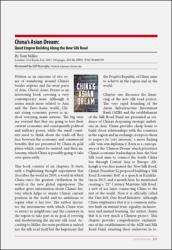| dc.description.abstract | Written as an outcome of two ye ars of wandering around China’s border regions and far-away parts of Asia, China’s Asian Dream is an interesting book covering a very contemporary issue. Although it seems much more related to Asia and the Euro-Asian world, Chi na’s rising economic power is in deed worrying many nations. The big ones are worried that they are going to lose their current economic and consequently political and military power, while the small count ries need to think about the trade-off they face between the economic and commercial benefits that are presented by China in gold plates which cannot be resisted, and their au tonomy, which China is possibly going to take over quiescently. This book consists of six chapters. It starts with a frightening thought experiment that describes the world in 2050, a world in which China–once the greatest civilization in the world–is the new global superpower. The author gives information about China’s his tory which helps to situate China’s current position in the world and its ambitions to regain what it has lost. The author discus ses the instruments with which China tries to attract its neighbours and the countries in the region to take part in its goal of reviving and modernizing the ancient silk road. Ac cording to Miller, the main problem is indeed not the silk road itself but the hegemony that the People’s Republic of China aims to achieve in the region and in the world. Chapter one discusses the finan cing of the new silk road project. The very rapid founding of the Asian Infrastructure Investment Bank (AIIB) and the establishment of the Silk Road Fund are presented as evi dence of China’s deepening strategic ambiti ons in Asia. China provides cheap loans to build closer relationships with the countries in the region and in exchange, it expects them to respect its ‘core interests,’ a move Beijing calls ‘win-win diplomacy.’ Born as a consequ ence of the ‘Chinese Dream’ which prioritizes China’s economic leadership in Asia, the New Silk road aims to connect the South China Sea through Central Asia to Europe. Alt hough it was first named the ‘New Silk Road,’ China’s President Xi proposed building a ‘Silk Road Economic Belt’ at a speech in Kazakhs tan in 2013, and a month later, he mentioned creating a ‘21st Century Maritime Silk Road,’ a web of sea lanes connecting China to the rest of the world. Now it is officially called the ‘One Belt, One Road Initiative.’ Although China emphasizes that it is a common initia tive built on mutual trust, equality, inclusive ness and mutual learning, the author claims that it is very much a Chinese project. This chapter provides comprehensive explanati ons of the establishment of the AIIB and Silk Road Fund, situating these endeavors in re lation to China’s passive position in existing
institutions such as the Asian Development
Bank, the IMF and the World Bank. It furtlher explains the supportive role of the China
Development Bank and the China Exim Bank
in financing China’s ambitious projects in the
country and overseas. After reading about
these activities, the reader unavoidably thinks
that the AIIB and Silk Road Funds are just
the tip of the icerberg and that the main part
of banking activities is hidden within China
itself. | en_US |

















